

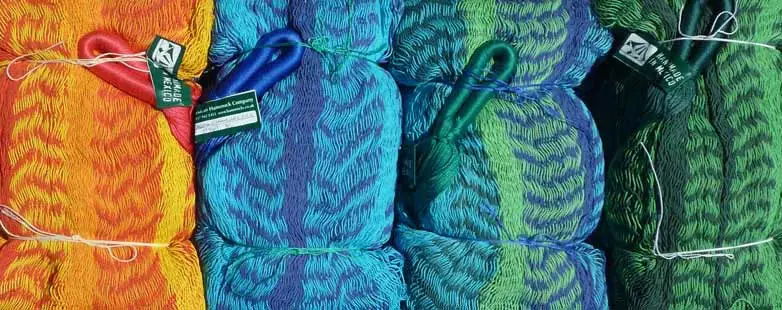

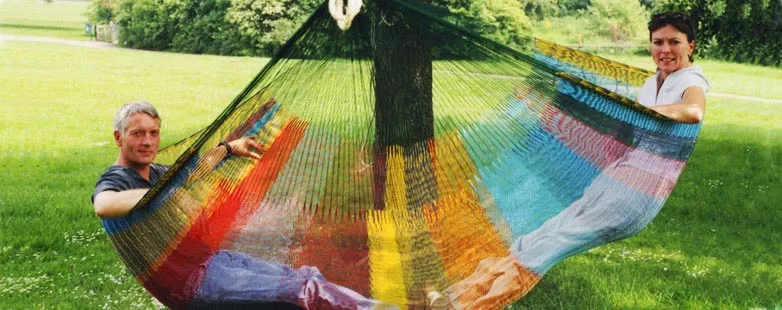

Closed weave cloth, fabric or canvas hammocks are the most common alternatives to open weave Mexican net hammocks. The majority of the cloth or fabric hammocks available today are from Brazil and are manufactured using a semi-automated process on a hand-operated loom. Whilst we identify with our Brazilian compadres when it comes to the need for more investment in local co-operative development projects, it would not be fair to realistically compare the quality of the end product or the conditions under which the hammocks have been made.
Cloth, fabric and canvas hammocks just do not have the same degree of stretch as Mexican net hammocks. The structure of the material with which they are made limits their ability to mould to the shape of the occupants body. There is no "give" in the hammock and the result is relatively constictive.
In short: There is no comparison when it comes to comfort. Mexican net hammocks win hands down over cloth, fabric and canvas hammocks.
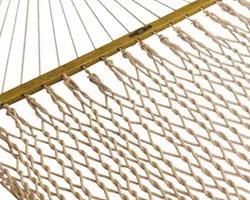
Spreader bar hammocks incorporate a rigid bar at each end of the hammock body to space out the connecting arm ends. This is a classic example of modifications being made to a thoroughly tried and tested design in order to attract consumers who may not have the space needed to accommodate a real hammock.
The addition of spreader bars results in a hammock which is "set" in it's shape and cannot adjust to the user's form. Spreader bar hammocks are notoriously unstable and difficult to get into and out of. These are the hammocks featured in those comedy hammock accident videos and should not be compared with a real Mexican hammock.
In short: For safety and comfort, choose a traditional Mexican hammock. This design is tried and tested and has been in use for over 4000 years.
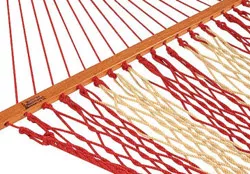
So called "rope hammocks" are generally made from chunky cotton rope or very thick thread and usually incorporate a spreader bar (see Spreader Bar Hammocks above).
Whilst rope or thick cotton thread hammocks might be more durable than classic Mexican net hammocks they do not open as wide and have much larger holes in the weave. With this type of hammock you can often feel your body being squeezed into the weave. The result is a hammock which is nowhere near as comfortable as a fine, closely woven net hammock. With true Mexican hammocks a weightless, floating sensation is achieved as the hammock stretches and moulds itself to your unique shape.
In short: If comfort is the main priority then a Mexican net hammock is the experts choice.
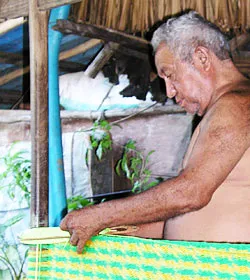
Cotton Mexican hammocks are the most comfortable hammocks you will find. Nylon Mexican hammocks are more resistant to wet weather and less prone to thread breakage, however there is a noticeable difference when it comes to the general feel of the hammock and the overall comfort.
A cotton Mexican hammock will last for many years when used with a reasonable amount of care. If you plan to use your hammock for extended camping trips in the Scottish Highlands or trekking in the Himalayas however, a nylon version would probably be a better choice.
In short: A cotton Mexican hammock is the most comfortable choice and will last many years when used with a reasonable amount of care.

Much is often attributed to the number of people that a hammock can hold. The terms Family Hammock, Double Hammock and Single Hammock are bandied about with relative ease and a lack of reference to the criteria used for their classification. In general the issue is not whether the hammock can hold the weight of a family but whether or not there is sufficient space inside the hammock to afford a reasonable degree of comfort.

Most cloth, fabric or canvas hammocks cannot stretch and hence, if they are large enough for a family, there will be a huge amount of excess material when used by a single person or a couple. Mexican Net hammocks will expand and contract to comfortably accommodate the user or users without this unwanted excess. The main difference between a Family hammock and a Double is in the width of the net - the length from handle to handle (and the space needed to hang them) is roughly the same.
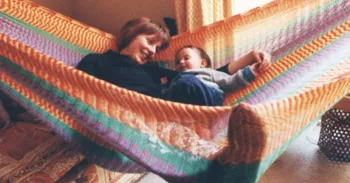
Our largest hammock, the Chacmool, provides the greatest degree of comfort when used by one person, a couple, or a whole family. The Cozaana hammock is commonly known as a "Familiar" in Mexico and whilst still very large, is not in the same league as the Chacmool. The main reasons for buying the Cozaana would be the lighter weight when packed and the cheaper price.
More information on size and quality can be found on the hammocks page in the catalogue section.
Handmade, handwoven and fairtrade are terms which are used ad infinitum in today's marketing literature, often with no apparent justification for such claims. All cloth or fabric hammocks are made using modern factory techniques or semi-automated processes with hand-operated looms. This is in stark contrast to the traditional hand weaving methods used by rural Mayan villagers. In these remote hamlets hammock weaving is not a wholly commercial affair but also a tradition and an integral part of ancient Mayan culture. The terms handwoven and handmade can be used here in the true sense of the words.
The Mexican Hammock Company was set up with the specific aim of developing a reliable alternative source of income in an area of high unemployment and relative poverty. The weavers themselves work on a job share basis and there are several villages involved in the scheme, the work and income being divided equally. The flow of hammocks from each village is deliberately kept from expanding too rapidly. This maintains a mixed local economy without disrupting the traditional cultural base of the village. The Mexican Hammock Company works directly with these villagers and follows a strict ethical trading code.
When comparing hammocks the experts agree, Mexican net hammocks win hands down over cloth, fabric and canvas hammocks. There is no comparison when it comes to style, safety and comfort. The design is tried and tested and has been in use for over 4000 years.